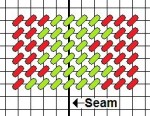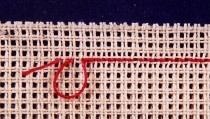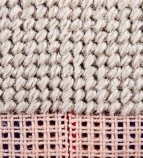Piecing Two Canvases Together
Many people like to stitch needlepoint rugs and large wall hangings. When working on a large canvas, you may prefer to work on a large floor frame. Or, you may wish to create your project on a smaller count canvas. If you do not want to handle a large piece of canvas, piecing is an option you may enjoy.
Penelope, interlock and mono canvas have definite sides. Long threads that run up vertically, parallel to the selvage, make up the warp. Threads running from left to right are called weft or woof. The selvage is the heavy woven edge running up and down on the canvas. It is impossible to successfully piece large squares together to make rugs or large tapestries without understanding this.
The warp and weft threads are not evenly spaced among each other. This can make piecing a bit of a problem. With a marker, make an arrow pointed up, showing the up/down or warp/weft pattern on the canvas. Place the canvas on stretcher bars with the arrow pointing up. When all the squares are finished, match the arrows in the same direction, and then continue to stitch the squares together.
Piecing Interlock or Mono Canvas
First, leave about half an inch of bare canvas in the area that will be seamed together. Do not leave a straight line of stitches running down the canvas. This creates a visible line once the project has been completed. Of course, if you use another color as a border around the motifs, this is not an issue.
Make a crease along the length of the two canvases aligning the grids of both. With a needle and strong, white thread, begin making cross hatches along the edges to unite both pieces. When you have finished stitching down the length, travel up the edges again to make a complete cross stitch. Small Cross or Running stitches are only one method for combining tow canvases.
Joining Penelope Canvas
The method is almost the same, with the following exception. When joining the canvas pieces together, make back stitches between the threads. Again, the grid should be lined up, and you should use strong matching thread to make the union. Both methods should be stitched with a dental floss or, for finer canvas, linen thread. Also, you should steam press the seam before you stitch for a flat result. Use caution in steam pressing any needlepoint stitches. This could flatten the fibers.














